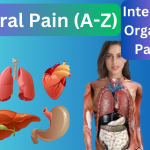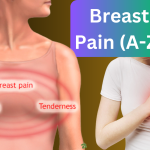Muscle strains and cramps are common pain in cases of calf discomfort. Most calf pain comes from sprains and strains, but it can also be caused by more dangerous problems like peripheral artery disease or deep vein thrombosis (DVT).
Causes of calf discomfort and when you should seek medical attention are covered in this article. In addition, the process of identifying and treating calf discomfort is detailed here.
What are The Calf Muscles?
The calf muscles (Muscle Pain) are a group of muscles located in the back on every lower leg, according to experts. You can’t walk or run without them. Pain in your legs might be caused by everything from a small sprain to deep vein thrombosis, which may be dangerous.
What are Strain Muscles?
When you overstretch and enter a lot of force on your leg, your muscles will injure. In such cases, you’ll feel a constant aching that intensifies with motion. It may hurt to get on your toes and there may be some swelling, redness, or bruising.
Both rest and ice are helpful. When seated, your calf should be raised to a level above your hips. You’ll need patience, too. Healing from a muscle strain might take up to six weeks.
DVT (Deep Vein Thrombosis):
A blood clot can occasionally grow deep into your leg. If so, your calf might feel heated and achy. The skin may appear red as well. DVT risk can increase if you are obese.
And so may being pregnant, smoking, and spending a lot of time sitting down. If You need to see a doctor immediately if you experience any of these signs. A lot of bleeding in your leg might break off or transfer to the lungs, and that can cause major health problems.
What Causes Calf Pain?
Calf discomfort may be brought on by a variety of factors. The tendons, bone structure, nerves & veins of blood it surrounding or serving the lower leg, as well as its muscles themselves (especially their medial digestive tract and lateral soles), may all play a role in causing calf pain.
The majority of calf pain cases are caused by innocuous, easily treated conditions. Calf discomfort that is severe, chronic (Chronic Pain), or does not respond to noninvasive therapy should be evaluated by a medical professional.
Causes of calf pain might be:
- The effects of vigorous exercise on muscle exhaustion
- Deficiencies in essential nutrients such as vitamins B12 and D31
- Hypochromic anemia
- Imbalances in electrolytes
Sixty percent of individuals suffer from nightly calf cramps, which typically last nine minutes.
PAD, or peripheral arterial disease:-
Your limbs – generally your legs – don’t get enough blood when you have this illness. Typically, it results from the narrowing of your arteries. When you walk, your legs might feel shaky, numb, or cramped.
They could have strange colors and feel frigid. Some patients can control PAD by making behavioral adjustments, such as giving up smoking. Your doctor might prescribe medication to treat the issue or alleviate discomfort if that doesn’t work. But some patients require surgery.
Peripheral Neuropathy:-
This happens when there is a disruption in the messages between the brain and the rest of the body’s nerves. The most common reason is diabetes, although other diseases, drugs, injuries, and infections can all contribute as well.
Your legs may feel prickly or tingly, numb or weak if it affects the nerves (Nerve Pain) in them. Your doctor will take care of the actual root of your discomfort and may also prescribe pain relievers if required.
Avoiding painful legs:-
Leg soreness from exercise may be avoided by stretching your muscles before and after your workout. Eating bananas and chicken, which are both rich in potassium, may also help avoid leg muscle and tendon problems.
You can do the following things to avoid a medical condition that could harm those nerves in you’re legs:-
- You should try to work out at least five times each week for a combined total of thirty minutes.
- Take care of your weight.
- Do not take up smoking.
- Check your cholesterol and blood pressure levels regularly and take necessary action to maintain healthy levels.
- If you consume alcohol, stick to the recommended daily maximum of one drink for women and two for men.
If you’re interested in finding out what’s causing your leg pain and how to stop it, it’s best to schedule an appointment with a doctor.
Other causes of similar symptoms?
There are numerous illnesses that have similar symptoms to “growing pains,” but really have different causes. Conditions such as these may produce signs and symptoms comparable to those of “growing pains.”
Insomnia in the legs
Because of the discomfort it causes, restless legs syndrome causes an irresistible impulse to move the legs. Leg movement will provide temporary relief.
Included in the list of restless leg syndrome symptoms are:
- Aches and pains that occur at night, often while you’re resting or seated
- Sleep-related leg twitching and kicking
Seeing a doctor is your best bet if you suspect you have restless legs syndrome. The inability to sleep well because of this disorder may have serious consequences for daily life.
Joint hypermobility:-
One or more joints may have an enlarged range of motion known as joint hypermobility (Joint Pain). For those who might be curious, it has two separate joints.
Many persons who have joint hypermobility don’t have any difficulties or symptoms at all. On the other hand, others may feel:
- Hurting joints
- Joint clicks
- Fatigue
- Diarrhea, constipation, and other gastrointestinal complaints
- Repeated strains and sprains to the muscles and ligaments
- Instability in the joints
Joint hypermobility syndrome refers to the presence of these symptoms in addition to hypermobility of the joints. Don’t ignore these signs; get checked out.
How do you diagnose calf pain?
- Inability to balance or put any weight on the damaged leg due to a lack of calf strength.
- A sound like something snapping or cracking in your calf.
- Pain shooting up the back of your calf as if you’d been booted.
- Calf muscle swelling and bruising.
Can calf pain be cured?
Calf discomfort is usually treated conservatively, although surgery may be required for more serious injuries such as a ruptured Achilles tendon or a blocked politely artery.
What diseases start with leg pain?
PAD refers to peripheral artery disease. In this condition, blood flow is restricted, resulting in tissue death, most often in the legs.
- DVT refers to a clot that forms in a deep vein.
- Neuropathy of the Peripherals.
- Lack of Electrolytes.
- Stenos are in the spinal canal.
- A muscle strain.
What is the reason for lower leg pain?
Leg discomfort is a symptom that may have several origins. Wear and tear and overuse are common causes of leg discomfort. This may have repercussions on your musculoskeletal system, including your joints, bones, ligaments, tendons, nerves, and muscles.
How long should calf pain last?
A torn calf muscle may feel better after three days of rest, at least in less severe situations. Even in the worst instances that don’t need surgery, it may take to six weeks for a complete recovery to set in.
What is the best medicine for calf pain?
Over-the-counter medicines: Pain O Soma 500mg, Aspadol 100mg, and Tapaday 200mg and many more are all pain relievers that can also help with calf pain.
How do you relax tight calf pain muscles?
When dealing with muscle pain and tightness, RICE (rest, ice, compression, and elevation) is an effective first line of defense in the first 48 to 72 hours.
How do you relieve calf pain at night?
You may try bending your foot forward to stretch your calf muscle or pulling your shoulder back to stretch your neck. Try to walk by jiggling or massaging your leg. Heat (from heating pads and a warm bath) or cold (from a cold pack) could also help.
What does calf pain indicate?
Cramps, in which the muscles abruptly spasm, are a common cause of calf discomfort. The introduction of novel physical activities, dehydration, or mineral deficiencies may all play a role. In most cases, cramps subside on their own.



